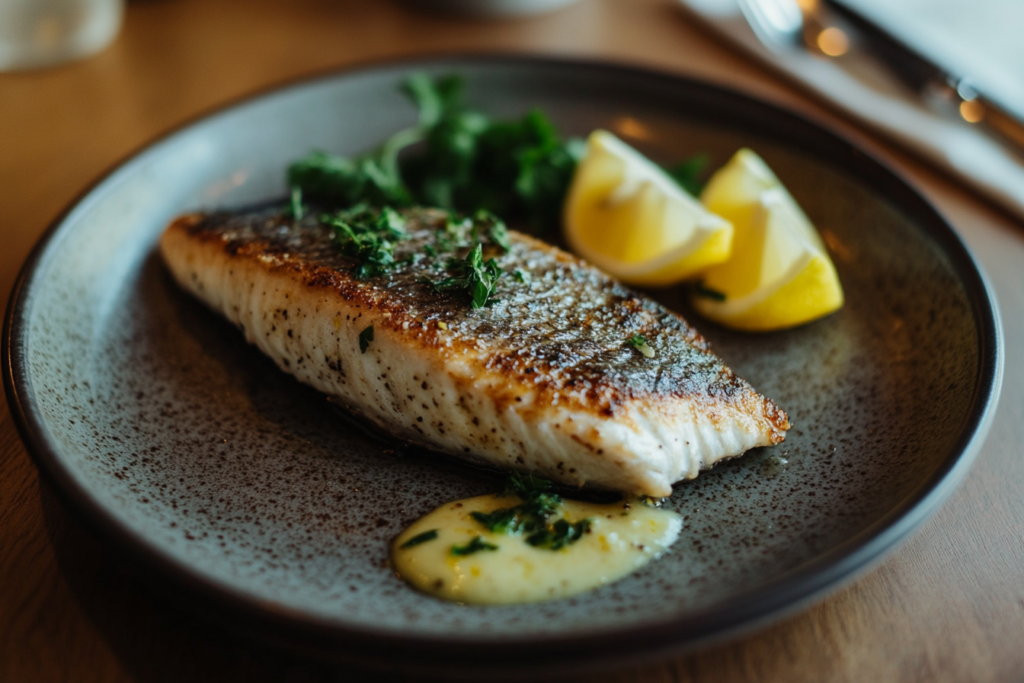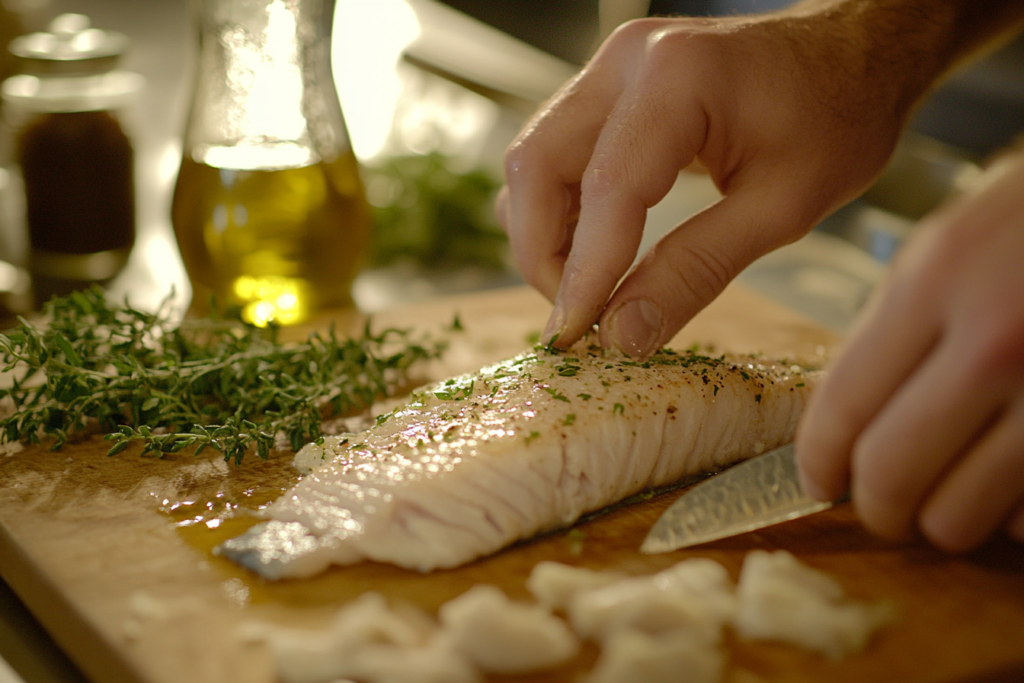Table of contents
Understanding Branzino: An Overview
Do you eat the skin of branzino? If not, you might be missing out on a nutritious and flavorful part of this popular fish
What is Branzino?
Branzino, also known as European sea bass, is a popular saltwater fish native to the Mediterranean Sea, the Black Sea, and the eastern parts of the Atlantic Ocean. Renowned for its mild, slightly sweet flavor and tender, flaky texture, branzino is a favorite choice among seafood enthusiasts and chefs alike. This fish typically measures around 1-3 pounds and is often prized for its delicate taste and versatility in culinary applications.
Its sleek, silver appearance and firm, moist flesh make it an attractive option for whole-fish presentations, grilling, and baking. Known as “lubina” in Spanish and “spigola” in Italian, branzino has a rich cultural presence in Mediterranean cuisines, where it is often paired with fresh herbs, citrus, and olive oil.
Nutritional Value of Branzino
Branzino is not only delicious but also packed with nutritional benefits. A rich source of lean protein, it provides essential amino acids necessary for muscle repair and growth. Additionally, branzino is low in calories and fat, making it an excellent choice for health-conscious diners.
Key nutrients found in branzino include:
- Omega-3 Fatty Acids: Promotes heart health, reduces inflammation, and supports brain function.
- Vitamins: Rich in vitamin D for bone health and vitamin B12 for energy production and nervous system health.
- Minerals: Contains selenium, phosphorus, and potassium, which are vital for metabolic processes and maintaining electrolyte balance.
With its combination of taste and health benefits, branzino is an ideal option for those looking to enjoy flavorful meals without compromising nutrition.
Culinary Importance of Branzino Globally
Branzino has earned its place in kitchens worldwide due to its adaptability and ability to absorb flavors beautifully. Its prominence in Mediterranean cuisine is unmatched, often featured in dishes like “branzino al forno” (oven-baked sea bass) or grilled whole with lemon and herbs. In Italian and Greek cooking, it is often served simply to let its natural flavors shine.
Beyond the Mediterranean, branzino has found favor in modern global cuisine, appearing on menus in upscale restaurants in North America, Asia, and beyond. Its mild taste makes it a versatile canvas for various culinary styles, from Asian-inspired steamed preparations to Latin American ceviche.
Chefs often prefer branzino for its delicate yet flavorful meat, making it suitable for steaming, roasting, grilling, or frying. Whether served as part of an elegant fine dining experience or a rustic seaside meal, branzino continues to be a celebrated ingredient that bridges culinary traditions across the globe.
Do you eat the skin of branzino, Yes or No ?
Is It Safe to Eat Branzino Skin?
Many wonder, ‘Can you eat branzino skin?’ The answer is yes, provided it is prepared properly. Branzino skin is thin, delicate, and crisps up beautifully when cooked, making it a popular choice for culinary enthusiasts who appreciate its texture and flavor. Like many other fish, branzino skin is edible and can be a delightful part of the dish when cleaned properly to remove scales and contaminants.
It is crucial to source your branzino from reputable suppliers to ensure it is free from harmful chemicals or pollutants that can sometimes accumulate in fish skin. Proper cooking, such as pan-searing or grilling, enhances the texture and makes the skin enjoyable to eat.

Health Benefits of Eating Branzino Skin
Eating branzino skin can offer several nutritional benefits, complementing the already healthful profile of the fish itself. Key advantages include:
- Rich in Omega-3 Fatty Acids: The skin often contains concentrated levels of these essential fatty acids, which are vital for heart health, brain function, and reducing inflammation.
- Source of Collagen: Fish skin is a natural source of collagen, which supports skin elasticity, joint health, and hair strength.
- Packed with Nutrients: The skin retains a variety of nutrients, including vitamins A and D, as well as essential minerals such as selenium and iodine, which are beneficial for immune function and thyroid health.
- Low in Calories: Branzino skin is a low-calorie option that adds texture and flavor to meals without significantly increasing caloric intake.
Incorporating branzino skin into your diet can elevate the dish nutritionally while enhancing its overall culinary appeal.
Possible Risks of Eating Fish Skin
While eating branzino skin is generally safe and nutritious, there are potential risks to be aware of:
- Chemical Contaminants: Fish skin can accumulate environmental pollutants, such as heavy metals (e.g., mercury) or pesticides. Choosing sustainably sourced or farmed branzino can mitigate this risk.
- Allergic Reactions: Individuals with fish allergies may also react to the skin. It is important to consult with a healthcare provider if unsure.
- Improper Cleaning: Unscaled or poorly cleaned fish skin may have remnants of scales or impurities that can affect texture and safety. Ensuring the skin is thoroughly cleaned is essential.
- Overcooking Concerns: Overcooked fish skin can become tough or rubbery, diminishing its appeal and making it less enjoyable to eat.
By selecting high-quality branzino and preparing it with care, the skin can be a delightful addition to your dining experience while delivering a range of health benefits.
How to Prepare Branzino for Optimal Skin Consumption

Proper Cleaning Techniques
Preparing branzino for optimal skin consumption starts with thorough cleaning to ensure safety and enhance its texture and flavor. Here are the steps:
- Scale the Fish: Use a fish scaler or the back of a knife to gently scrape off the scales. Work from the tail to the head in smooth, consistent strokes. Rinse the fish under cold running water to wash away any loose scales.
- Remove Impurities: Pay special attention to the skin, ensuring it is free from any slime or residue. Pat it dry with a clean kitchen towel or paper towel.
- Score the Skin: Make shallow diagonal cuts across the skin to prevent it from curling during cooking. Be careful not to cut into the flesh.
- Inspect for Quality: Ensure the fish is fresh, with a shiny skin, clear eyes, and no off-putting odors. Fresh fish enhances both flavor and safety.
Proper cleaning not only ensures the skin is safe to eat but also prepares it to crisp up beautifully during cooking.
Cooking Methods that Retain Flavor and Texture
The right cooking method can make the difference between tough, rubbery skin and perfectly crisp, flavorful skin. Here are the most effective techniques for preparing branzino skin:
- Pan-Searing:
- Heat a non-stick or cast-iron skillet with a drizzle of oil over medium-high heat.
- Place the branzino skin-side down and press lightly with a spatula to keep it flat.
- Cook until the skin is crispy and golden brown, then flip briefly to finish cooking the flesh.
- Grilling:
- Preheat the grill and lightly oil the grates to prevent the food from sticking.
- Brush the fish skin with oil and place it skin-side down on the grill.
- Cook over medium heat until the skin is crisp and slightly charred.
- Oven-Roasting:
- Preheat the oven to 400°F (200°C).
- Place the fish on a baking sheet lined with parchment paper or foil, skin-side up.
- Brush the skin with oil and bake until crisp and the flesh is tender.
- Steaming (for softer skin): If you prefer tender skin, steaming is a great option. However, this method won’t produce crispy skin.
Best Seasoning for Crispy Branzino Skin
The right seasoning enhances the natural flavor of branzino without overpowering it. For crispy skin, keep the seasoning simple and complementary:
- Basic Seasoning:
- Salt: Generously season the skin with coarse salt before cooking to draw out moisture, ensuring crispiness.
- Pepper: Freshly cracked black or white pepper adds a subtle kick.
- Herbal Blends:
- Rosemary, thyme, or dill pair beautifully with the fish.
- Rub the herbs onto the skin along with salt and oil for aromatic flavor.
- Citrus Zest:
- Lemon or lime zest adds a refreshing brightness. Sprinkle over the skin after cooking.
- Spices for Bold Flavors:
- Paprika, garlic powder, or a dash of chili flakes can elevate the dish with a hint of spice.
- Finishing Touches:
- After cooking, drizzle with olive oil, or add a squeeze of fresh lemon juice to enhance the flavor.
By combining proper cleaning, precise cooking techniques, and thoughtful seasoning, you can create a branzino dish that highlights the skin’s crisp texture and rich flavor.
Cultural Perspectives on Eating Fish Skin
Mediterranean Traditions
In Mediterranean cuisines, eating fish skin is a deeply rooted tradition that reflects the region’s emphasis on simplicity and natural flavors. Whole branzino is often served roasted or grilled, with the skin intact and crisped to perfection.
- Culinary Approach: Mediterranean cooks value fish skin for its ability to lock in moisture and enhance the flavor of the dish. Techniques such as grilling over open flames or baking with olive oil, herbs, and citrus are popular.
- Symbol of Resourcefulness: The tradition of consuming fish skin aligns with the Mediterranean ethos of minimizing food waste and appreciating the entire fish.
- Health and Flavor: In countries like Greece, Italy, and Spain, the skin is prized not only for its crispy texture but also for its nutritional benefits, such as omega-3 fatty acids and vitamins.
Asian Cuisine and Fish Skin Delicacies
In many Asian cultures, fish skin is not just an accompaniment but often a centerpiece of culinary innovation. It is valued for its texture, versatility, and ability to absorb bold flavors.
- Crispy Fish Skin Snacks: In Chinese cuisine, fried fish skin seasoned with salt, pepper, or chili is a popular snack and garnish. These crispy treats are commonly found in street markets and modern fusion restaurants.
- Hot Pot and Soups: Fish skin is frequently added to hot pots and broths, where it absorbs rich flavors and contributes a gelatinous texture.
- Steamed or Pan-Fried: In Japanese cuisine, fish is often steamed or pan-fried with the skin left intact to preserve its moisture and enhance presentation.
- Symbolism: In some Asian cultures, eating fish skin is associated with prosperity and good fortune, particularly during festive occasions.
Western Views on Eating Fish Skin
In Western culinary traditions, attitudes toward eating fish skin have evolved, particularly with the rise of sustainable and gourmet cooking practices.
- Fine Dining Trends: High-end restaurants and chefs have embraced fish skin as a gourmet element. Crispy skin on fish dishes is now a hallmark of sophisticated plating, adding both texture and visual appeal.
- Health Consciousness: The growing awareness of the nutritional benefits of fish skin has led to its increased acceptance. Omega-3 fatty acids, collagen, and vitamins make it appealing to health-focused diners.
- Home Cooking Practices: In Western households, some individuals remain hesitant about eating fish skin due to concerns over cleanliness or texture. However, with proper preparation techniques, crispy fish skin is becoming more popular in everyday meals.
- Traditional Avoidance: Historically, fish skin was often discarded in Western kitchens due to a preference for fillets. However, this is changing with the shift toward more sustainable eating habits.
Across cultures, the approach to fish skin reflects broader culinary values and traditions. Whether it’s a staple in Mediterranean cooking, a delicacy in Asian cuisine, or an emerging trend in Western dining, fish skin continues to gain recognition for its flavor, versatility, and health benefits.
If you’re wondering whether branzino skin is safe and enjoyable to eat, understanding its culinary and nutritional benefits is essential. For those interested in expanding their branzino knowledge, check out this branzino recipe easy cooking guide for preparation tips that highlight the crispy skin. Curious about the fish itself? Learn more about what kind of fish branzino is to appreciate its unique qualities. Additionally, explore whether branzino is a good fish to understand why it’s favored in Mediterranean and global cuisines.
FAQs About Eating Branzino Skin
Should I eat branzino skin?
Yes, you can eat branzino skin, and many people enjoy it for its crispy texture and added flavor when cooked properly. Branzino skin is thin and delicate, making it particularly appealing when pan-seared or grilled. It is safe to eat as long as the fish has been cleaned thoroughly, and the skin has been cooked to enhance its texture.
Do you eat the whole branzino?
Yes, eating a whole branzino is common in many cuisines, especially Mediterranean cooking. The fish is often served whole, roasted, or grilled, allowing diners to enjoy the tender meat from various parts of the fish, including the cheeks and collar, which are considered delicacies. While the flesh and crispy skin are commonly consumed, inedible parts such as bones, fins, and the head (unless desired for soups or stocks) are typically discarded.
How do you remove the skin from branzino?
If you prefer not to eat the skin, it can be removed easily either before or after cooking:
- Before Cooking:
- Use a sharp knife to make a shallow cut at the tail end.
- Hold the fish firmly by the tail and gently slide the knife between the flesh and skin, working it forward while keeping the blade angled slightly upward.
- Peel the skin away as you cut.
- After Cooking:
- Cook the fish with the skin on to retain moisture.
- Once cooked, use a fork or knife to lift the skin, which should come off easily when separated from the flesh.
Removing the skin is a personal choice, but many people leave it on to enjoy its texture and flavor.
Is it okay to eat the skin on fish?
Eating fish skin is entirely optional and depends on personal preference and cultural tradition. In general:
- Yes for Edible Fish Skin: Fish like branzino, salmon, and trout have thin, flavorful, and nutrient-rich skins that are safe and enjoyable to eat when properly cooked.
- No for Tough or Thick Skin: Some fish, like catfish or swordfish, have tough skins that are better removed before eating.
For the best experience, ensure the skin is clean and free of scales, and prepare it using a cooking method that enhances its texture, such as pan-searing or grilling.
Conclusion
Recap of Benefits and Risks
Eating branzino skin can be a delightful culinary experience, offering a crispy texture, enhanced flavor, and a host of nutritional benefits such as omega-3 fatty acids, collagen, and essential vitamins. Proper preparation and sourcing are key to maximizing these advantages while minimizing potential risks like chemical contaminants or improper cleaning. Whether you prefer it crispy or tender, branzino skin can elevate your meal both nutritionally and gastronomically.
Encouragement to Try It Safely
If you’ve never tried eating branzino skin, it’s worth giving it a shot! Ensure you purchase your fish from a reputable source, clean it thoroughly, and cook it with care to bring out its best qualities. With its delicate flavor and rich texture, branzino skin is an easy way to add sophistication and nutrition to your seafood dishes. Dive into the experience and enjoy this culinary treasure safely and deliciously!

